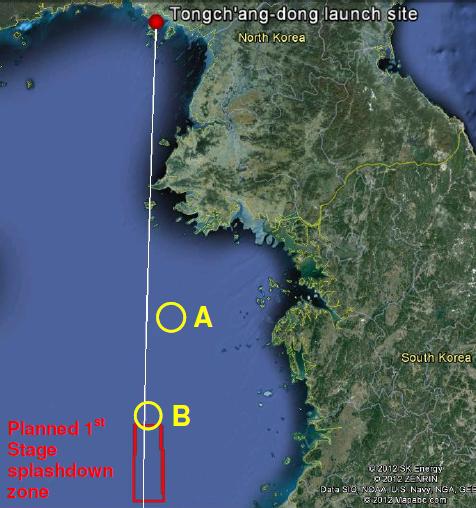Following North Korea’s launch failure in April 2012, we were left with conflicting reports about its cause, and even when it happened during the launch and where the debris fell to earth. A December 4 report in Kyodo News may shed some light on this, but leaves lots of questions.
The story reports that “Japanese government sources” recently said that:
For about half a year since the April 2012 launch, the Japanese and U.S. defense authorities examined telemetry data emitted by the rocket as well as the tracking data obtained via U.S. military radar, according to the sources.
“Telemetry” is information the launcher sends back about how its internal components are working during the launch—it’s like the “black box” of aircraft, except the information is radioed back during the launch. Scientists and engineers designing the rocket use this data to diagnose and fix problems, but others can intercept this data as well. On top of gathering this information, the U.S., Japan, and South Korea all had radars and other sensors in the region for the test—on the ground as well as on planes and ships—so they should have lots of data to sort through.
The Kyodo report is interesting in part because if U.S. and Japanese experts were poring over the data until October or November to understand the failure, it calls into question whether North Korean engineers could have identified and remedied the problems in time for a December launch.
The most interesting claims in the Kyodo report are that “the rocket veered to the east immediately after liftoff,” and that the first stage burned all its fuel but the second stage did not ignite.
Assuming these claims are true and combining them with information released around the time of the launch, we can speculate about what may have happened. Reports at the time gave two different locations for where the rocket splashed down. NORAD and US Northern Command announced a splashdown point near Point A in Figure 1, while South Korean sources indicated a splashdown near Point B, which is at the northern end of the hazard zone (red rectangle) where North Korea announced the first stage would land in an successful launch.
If the launcher began to veer east of the intended path very soon after liftoff, that could have been caused by a faulty guidance system, but the fact that North Korea was able to keep the rocket from going wildly off course suggests otherwise. It’s possible instead that one of the first-stage engines—the stage carries four engines bundled together—might not have worked properly. The resulting imbalance of thrust between the four engines could have caused the rocket to veer off course until the guidance system compensated to put it back on a southern course. If the stage burned to completion but was only getting full thrust from three engines, that would reduce its burnout speed and the distance it could travel. This explanation is consistent with the first stage landing at Point A, since it is east of the intended path and only about three-quarters of the way to the intended splashdown zone.
It is also possible that the problem was caused by a structural failure of the upper stages, as was stated in some press stories at the time. This failure could cause the upper stages to bend, resulting in unequal atmospheric forces on the sides of the rocket that could have pulled the rocket to the east. The additional drag this would cause on the launcher and the extra fuel needed to compensate for these forces and keep the rocket generally on course would have caused it to fall short of the planned splashdown zone. This explanation also seems to be consistent with Point A rather than Point B.
However, you might expect such a failure would not occur “immediately” after launch but perhaps 30-40 seconds after liftoff when the atmospheric drag forces on the front of the rocket were becoming significant (Figure 2). So if the rocket began to veer “immediately” that might suggest an engine problem was the more likely explanation.

Figure 2: This curve shows the atmospheric drag force, which is proportional to dynamic pressure, on the rocket early in flight. (Source: http://allthingsnuclear.org/north-koreas-launch-failure-and-max-q/)
In either case, if the second stage did not ignite, it would have fallen into the water around the same place as the first stage, and would have carried the third stage and satellite with it.
I want to emphasize that until we get additional information, these explanations remain speculative. Hopefully if the U.S.-Japanese analysis is completed, more may come out soon about April’s failure.

